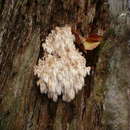en
names in breadcrumbs


Hericium flagellum is a species of fungus in the family Hericiaceae[1] native to Europe, first described by Giovanni Antonio Scopoli, and placed into its current genus by Christiaan Hendrik Persoon in 1797. It was confirmed—using sexual incompatibility studies—to be a distinct species from H. coralloides in 1983. Found in montane areas, typically on newly fallen trunks and stumps of fir (Abies species), especially silver fir[2] with one study finding over half of recorded specimens growing on silver fir deadwood in high conservation value areas.[3] Spores are 5–6.5 by 4.5–5.5 µm.[4][5]
Hericium flagellum is a species of fungus in the family Hericiaceae native to Europe, first described by Giovanni Antonio Scopoli, and placed into its current genus by Christiaan Hendrik Persoon in 1797. It was confirmed—using sexual incompatibility studies—to be a distinct species from H. coralloides in 1983. Found in montane areas, typically on newly fallen trunks and stumps of fir (Abies species), especially silver fir with one study finding over half of recorded specimens growing on silver fir deadwood in high conservation value areas. Spores are 5–6.5 by 4.5–5.5 µm.